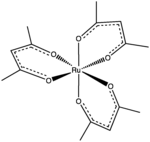
| |

| |
| Names | |
|---|---|
| IUPAC name
Tris(acetylacetonato)ruthenium(III)
| |
| Other names
Ru(acac)3; Ruthenium(III) 2,4-Pentanedionate; Ruthenium(III) acetylacetonato, 2,4-pentanedione ruthenium(III)
| |
| Identifiers | |
3D model (JSmol)
|
|
| ECHA InfoCard | 100.034.705 |
| EC Number |
|
PubChem CID
|
|
CompTox Dashboard (EPA)
|
|
| |
| |
| Properties | |
| (C5H7O2)3Ru | |
| Molar mass | 398.39 g/mol |
| Appearance | Dark violet solid |
| Density | 1.54 g/cm3[1] |
| Melting point | 260 °C (500 °F; 533 K) |
| insoluble in water | |
| Solubility | soluble in most organic solvents |
| Hazards[2] | |
| GHS labelling: | |

| |
| Warning | |
| H302, H315, H319, H335, H413 | |
Except where otherwise noted, data are given for materials in their standard state (at 25 °C [77 °F], 100 kPa).
| |
Ruthenium(III) acetylacetonate is a coordination complex with the formula Ru(O2C5H7)3. O2C5H7− is the ligand called acetylacetonate. This compound exists as a dark violet solid that is soluble in most organic solvents.[3] It is used as a precursor to other compounds of ruthenium.
- ^ Chao, G.; Sime, R. L.; Sime, R. J. (1973). "Crystal and molecular structure of tris(acetylacetonato)ruthenium(III)". Acta Crystallographica B. 29 (12): 2845. doi:10.1107/S0567740873007636.
- ^ "C&L Inventory". echa.europa.eu.
- ^ R. C. Mehrotra, R. Bohra, and D.P. Gaur "Metal β-Diketonates and Allied Derivatives", 1st ed.; Academic Press inc.: New York, 1978. ISBN 0-12-488150-5.